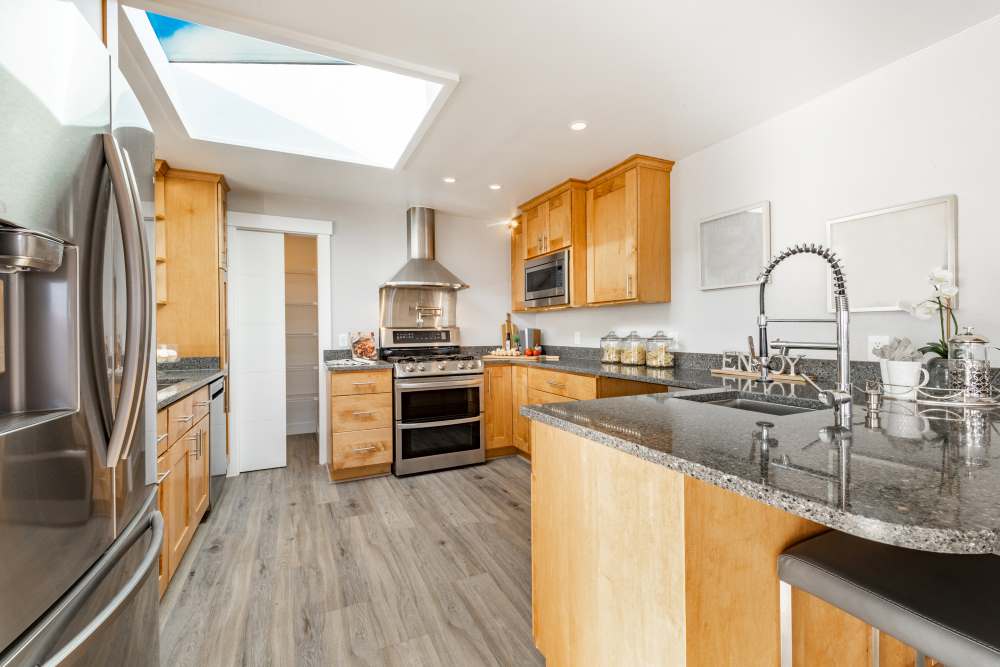
Have you ever felt a little down on a gray, dreary day? The lack of natural light can negatively impact our moods and well-being. But bringing more sunlight into your home doesn't need to mean installing huge windows everywhere. A strategically placed skylight can flood interior rooms with a wave of brightness to lift your spirits. More than just a design element, skylights offer benefits that span beyond aesthetics.
Harnessing the power of sunlight, a skylight is a simple way to brighten your mood and energize your living spaces. In this guide, we'll explore how adding a skylight can significantly improve the overall health of your home through increased circadian rhythm regulation, air purification, and maintaining a livable temperature.
Why Choose a Skylight?
Sunlight has always been a coveted element in home design, not just for its aesthetic appeal but for the remarkable benefits it brings to our daily lives. A skylight is more than a window; it's a portal to the natural world, offering a unique connection to the sky above. Below, we will elucidate on the multifaceted advantages of installing a skylight in your home, underscoring how it can transform your living environment.
Natural Light Enhances Mood
Exposure to natural light has been scientifically proven to boost serotonin levels, a key hormone that stabilizes our mood, feelings of well-being, and happiness. Skylights, by allowing more sunlight into your home, can combat seasonal affective disorder (SAD) and reduce the blues linked with prolonged exposure to artificial lighting.
Improved Air Quality
Skylights that open can contribute significantly to the ventilation of a home, promoting air circulation. This natural ventilation helps in reducing moisture levels, thereby minimizing the risk of mold and mildew growth. Fresh air not only improves the quality of your indoor environment but can also lead to better health for you and your family.
Energy Efficiency
A skylight can reduce the need for artificial lighting during the day, which not only cuts down on electricity bills but also conserves energy. Additionally, in colder months, a strategically placed skylight can contribute to warming the home, thanks to the greenhouse effect, further reducing the need for heating and, thereby, your home's carbon footprint.
Aesthetic Improvement and Increased Property Value
Adding a skylight not only elevates the overall aesthetics of your home but can also increase its market value. Natural light brightens rooms in a way artificial light cannot, making spaces appear larger and more inviting. This visual enhancement can be a critical selling point, potentially making your property more desirable to prospective buyers.
Enhanced Productivity and Focus
The presence of natural light has been linked to improved productivity and focus. Studies have shown that environments with ample sunlight can help individuals feel more energetic and concentrated, which is particularly beneficial for home offices or study areas. A skylight can transform your workspace into a more motivating and productive environment.
Connection with the Outdoors
Skylights provide a unique visual connection to the outdoors, helping to bring a little bit of nature into your home. This connection can be particularly therapeutic, offering a sense of openness and freedom that traditional windows may not provide. Whether it’s watching clouds drift by during the day or stargazing at night, skylights create moments of beauty and tranquility that enhance overall well-being.
How to Choose the Best Skylight for Your Home
Selecting the perfect skylight for your home involves more than just aesthetics; it's about enhancing functionality, boosting energy efficiency, and improving your living space's overall atmosphere. In this section, we'll cover crucial factors to consider when choosing a skylight, ensuring you make an informed decision that aligns with your home's specific needs and your personal preferences.
Consider the Skylight Type
There are various types of skylights available, including ventilating, fixed, and tubular. Ventilating skylights can be opened to allow air circulation, making them ideal for kitchens and bathrooms. Fixed skylights, as the name suggests, do not open but are excellent for adding additional light. Tubular skylights are perfect for smaller spaces, channeling sunlight through a reflective tube to brighten the area.
Assess the Location and Orientation
The location of a skylight significantly impacts its effectiveness. North-facing skylights provide consistent illumination, while south-facing ones can offer passive solar heating during the winter. However, consideration must be given to the potential for overheating and glare. It’s important to evaluate the specific rooms where skylights could enhance light quality and determine their best orientation.
Choose the Right Glazing
Skylight glazing can be made from plastic or glass, with each material offering different benefits. Glass is more durable and provides better clarity and UV protection, especially if it's double-glazed and filled with inert gas for added insulation. Plastic glazing is less expensive but may not last as long and can discolor over time. The choice between these materials should be based on the specific requirements of your home and climate.
Consult a Professional
Perhaps the most crucial step in choosing a skylight is consulting with a professional. A skilled contractor or reliable roofing company can provide valuable insights into the best type of skylight for your home, considering structural integrity, local climate, and your home’s architectural style. They can also ensure that the installation is handled correctly, preventing leaks and other potential issues that could arise from improper installation.
Opt for Energy-Efficient Models
When selecting a skylight, energy efficiency should be a top priority. Look for models that have a low U-factor, which measures the window's capacity to insulate. Additionally, consider skylights with a low Solar Heat Gain Coefficient (SHGC) to minimize the amount of solar heat that enters your home, preventing overheating during warmer months. Choosing energy-efficient skylights can significantly reduce your heating and cooling costs while maintaining a comfortable indoor environment.
Maintenance and Durability
Maintenance is an important aspect to consider when choosing a skylight. Opt for materials and designs that are known for their longevity and ease of maintenance. For example, glass skylights with protective coatings can resist weathering and require less cleaning. Ensure that the skylight’s design allows for easy access for cleaning and maintenance tasks. Additionally, assessing the warranty offered by the manufacturer can provide insights into the skylight’s durability and the company's confidence in its product.
Integrate with Smart Home Systems
For added convenience and energy savings, consider integrating your skylight with smart home systems. Automated skylights can be programmed to open and close at specific times to optimize natural lighting and ventilation, which can help in reducing reliance on artificial lighting and HVAC systems. Some models can even be equipped with rain sensors to automatically close when precipitation is detected, preventing water from entering your home. Integrating smart technology with your skylight enhances its functionality and makes it easier to manage your home’s environment.
Final Thoughts
A skylight can be a valuable addition to any home, offering numerous benefits that enhance the overall living experience. From natural light and energy efficiency to improved productivity and connection with the outdoors, skylights offer a range of advantages that make them worth considering for any homeowner. By carefully evaluating your options and consulting with professionals, you can choose the best skylight for your home and enjoy its benefits.



























